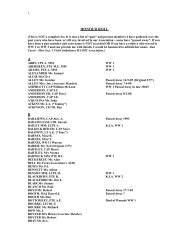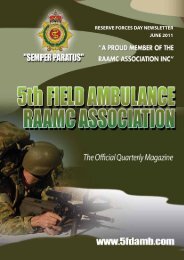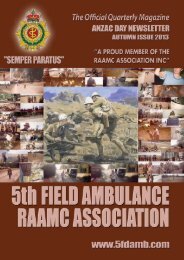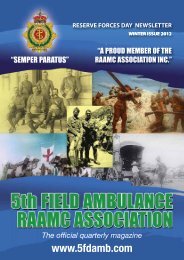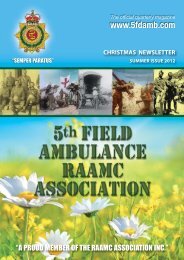2010 Paulatim Magazine - RAAMC Association
2010 Paulatim Magazine - RAAMC Association
2010 Paulatim Magazine - RAAMC Association
You also want an ePaper? Increase the reach of your titles
YUMPU automatically turns print PDFs into web optimized ePapers that Google loves.
Health Branch HQ Forces Command<br />
A Year in Review<br />
It has been a privledge working with a very busy and dedicated team of<br />
health professionals posted to Health Branch HQ Forces Command over<br />
the past 12 months. The support Army Health has received from the<br />
Command and staff of Forces Command has enabled us to truly realise<br />
three key initiatives: The Army Combat Health Restructure, the roll-out<br />
of Exercise Primary Survey series of Health - Mission Specific Training<br />
and the initial planning for the role out of the Comprehensive Soldier<br />
Fitness program which we hope to profile next year.<br />
systems has changed the nature and mechanism of injury; therefore,<br />
health effect (personnel, medical equipment and training) will need to<br />
be adaptive and responsive. The LBTS seeks to deliver this requirement<br />
by providing a modular and scaled force, trained and equipped for this<br />
need. The system focuses on providing quality, timely care from the<br />
most forward deployed elements of the force through to the rapid<br />
response, evacuation and stabilisation of casualties across the entire<br />
battle space.<br />
PAULATIM<br />
The Forces Command Health Team comprises of: Col Charles New<br />
(Reserve), LTCOL Paul Rogers, LTCOL David Collins, LTCOL Brian<br />
Johnston, LTCOL Julie Finucane (Reserve) LTCOL Rod Pedersen<br />
(Reserve) MAJ Mick Kent, MAJ Paul Morgan, MAJ Sean Kennaway,<br />
MAJ GreG Brown (Reserve), CAPT Carol Waldeck, The mighty WO1<br />
Team of Liz Matthews, Tania Harmer, Clay Baker and Lyn Daly and our<br />
admininistrative support Officer – Hanna Al-Dainy.<br />
ARMY HEALTH SUPPORT FORCE<br />
MODERNISATION<br />
From the on-set the notion of challenging the traditional paradigm<br />
of Army health structures was going to be a tough call. However,<br />
three years of analysis, review, discussion, argument and finally logic<br />
identified that challenging the organisation to accept that a change<br />
to those traditional structures was the only way forward was finally<br />
agreed upon.<br />
The challenge of recruiting and retaining qualified health personnel,<br />
the demanding training regime, cost of medical equipment and clinical<br />
governance requirements of a deployable health capability now<br />
confronts the Army. The recognition of the Land Based Trauma System<br />
(LBTS) within the ADF Combat Health Operating System (CHOS) enables<br />
Army to rebalance its combat health to optimise its deployable effect<br />
and redress employment structures issues. The size and mix of the<br />
capabilities to be delivered to support the LBTS under the auspices of<br />
the Combat Health Support (CHS) structure has been at the forefront<br />
of considerations for Army health over the last three years.<br />
The integration of the Full Time and Part Time health workforce was<br />
part of the analysis and is articulated in the detail of the CHS structures.<br />
Land Based Trauma System. Army health units now and into the<br />
future will be required to conduct a multitude of tasks within a joint<br />
taskforce setting, at short-notice, across the full spectrum of conflict.<br />
The progress in design and subsequent introduction of various weapon<br />
This system has been developed based upon the 10 minute – 60<br />
minute – 2 hour metric. 1 This system is based on the guiding principles<br />
of proximity and responsiveness and applied to land based operations.<br />
The LBTS will introduce the following capability to Army CHS for Land<br />
based operations as follows:<br />
a. a structure capable of delivering a robust CHS effect further<br />
forward on the battlefield;<br />
b. establishment of new Shock Trauma and Aero-Medical Evacuation<br />
capabilities;<br />
c. a structure that addresses current clinical capability gaps in CHS,<br />
such as the void of asset in 7 Bde;<br />
d. a centralised CHS structure that facilitates better coordination of<br />
support to meet Army RTS, MST and GHS requirements;<br />
e. an enhanced structure to maximise the ‘high end’ ARES health<br />
professional integration into Army health structures;<br />
f. improved operational mental health training;<br />
g. the establishment of the Combat Health Training Team (CHTT) that<br />
the bridges the gap between extant individual training<br />
establishments and those required to support foundation<br />
warfighting and MST;<br />
h. establishment of structures to support significant CA initiatives<br />
related to Welfare Boards and management and rehabilitation of ill<br />
and injured personnel; and<br />
i. establishment of Aviation Medicine airworthiness health advice to<br />
COMD FORCOMD.<br />
j. Force Health Protection System. The Land Based Health<br />
Protection System (LBHPS) has two sub-systems:<br />
i. The Primary Health Care System (PHCS) provides primary<br />
care to NSA standards where possible. PHCS facilities including<br />
PA U L AT I M – M A GAZINE O F T HE R OYA L A U S T R A L I A N A R M Y M E DICAL C O R P S – 2 0 1 0 1 1



